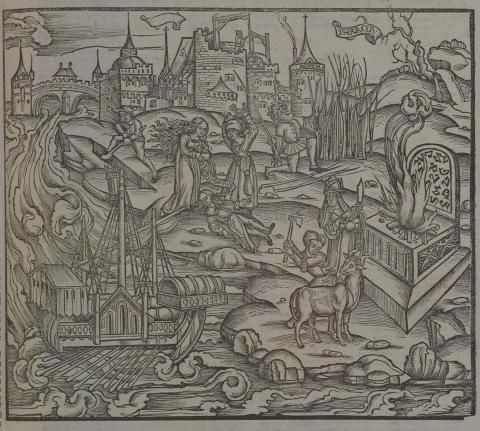Annotations
At the top left of the image, one of Aeneas's men digs a trench to begin founding a new city (16-8); the ship sitting in the harbor in the lower left shows that they have just arrived at this place. In the bottom right, a priest and an attendant prepare a sacrifice to Venus at an altar (19-21). Behind them, Aeneas is on one knee beside a stand of trees that turn out to be spears. He has already pulled up two spear shafts, and holds a third in his hand, and looks a bit surprised, as though the voice of Polydorus has begun to speak (22-46). In the middle of the image, Polydorus is shown lying dead with two women standing over him, a detail picked out from lines 62-8, in which the Trojans give Polydorus a proper burial (Ergō īnstaurāmus Polydōrō fūnus, et ingēns/ aggeritur tumulō tellūs; stant Mānibus ārae/ caeruleīs maestae vittīs ātrāque cupressō,/ et circum Īliades crīnem dē mōre solūtae). The city in the background is the home of the Thracian king (50-1); Virgil does not give it a name.
Woodcut illustration from the “Strasbourg Vergil,” edited by Sebastian Brant: Publii Virgilii Maronis Opera cum quinque vulgatis commentariis expolitissimisque figuris atque imaginibus nuper per Sebastianum Brant superadditis (Strasbourg: Johannis Grieninger, 1502), fol. 185r, executed by an anonymous engraver under the direction of Brant.


Sebastian Brant (1458–1521) was a humanist scholar of many competencies. Trained in classics and law at the University of Basel, Brant later lectured in jurisprudence there and practiced law in his native city of Strasbourg. While his satirical poem Das Narrenschiff won him considerable standing as a writer, his role in the transmission of Virgil to the Renaissance was at least as important. In 1502 he and Strasbourg printer Johannes Grüninger produced a major edition of Virgil’s works, along with Donatus’ Life and the commentaries of Servius, Landino, and Calderini, with more than two hundred woodcut illustrations. (Annabel Patterson)